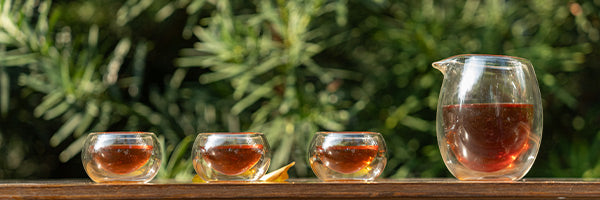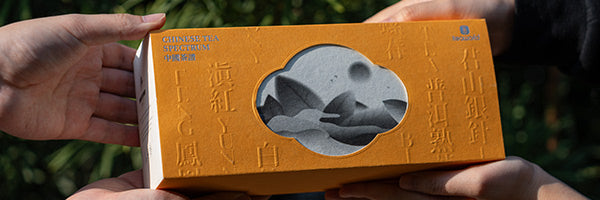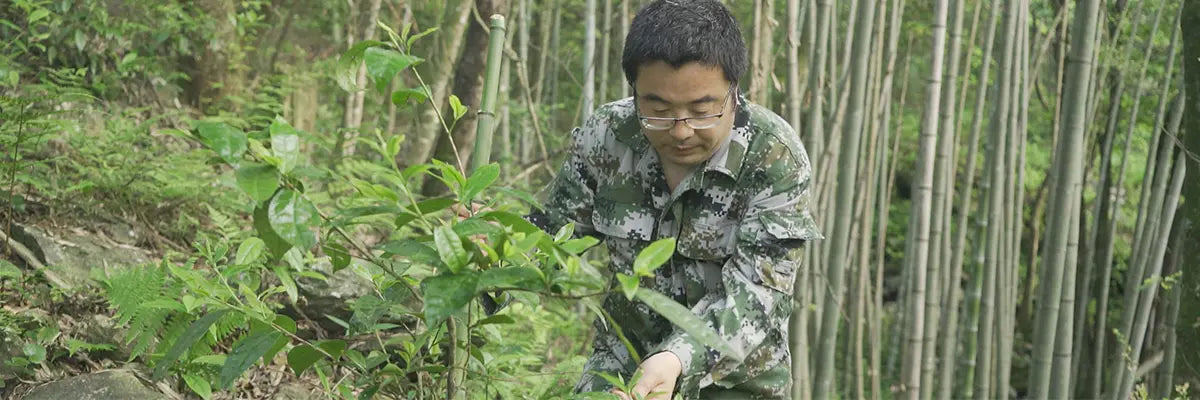Многие люди имели опыт наслаждения ароматным и насыщенным листовым зеленым чаем в чайном магазине, со сладким и освежающим вкусом, который остается на нёбе. Однако, как только они покупают его и заваривают дома, они, похоже, не могут воссоздать это удивительное ощущение. Поэтому меня часто спрашивают: почему чай, который я покупаю, не такой вкусный, как тот, который я ел в магазине?
Частично причина в различной окружающей среде, которая может влиять на восприятие вкуса. Другой фактор связан с методом заваривания, используемым для листового зеленого чая. Ниже давайте рассмотрим некоторые методы, которые позволят сделать вкус листового зеленого чая еще лучше.
1.Выбор правильной посуды для чая - стеклянная чашка

Потягивание листового зеленого чая — это не просто дегустация; это комплексный процесс, включающий в себя наслаждение ароматом, наблюдение за танцем чайных листьев и оценку вкуса.
Умение ценить чай также является важным аспектом чайной культуры. Поскольку чайные листья постепенно раскрываются в чашке, волнообразно поднимаясь и опускаясь, стеклянная чашка позволяет лучше оценить динамическую красоту чайных листьев. В неторопливом и беззаботном настроении это похоже на наблюдение за «танцем зеленого чая». В таких ситуациях наиболее подходящей посудой для заваривания листового зеленого чая, естественно, является прозрачная стеклянная чашка.
2.Выбор качественного листового зеленого чая

Чтобы по-настоящему оценить изысканное очарование листового зеленого чая, важно выбрать высококачественный листовой зеленый чай. Различные сорта листового зеленого чая обладают различными вкусами и характеристиками, поэтому выбор должен основываться на личном вкусе и предпочтениях. Например, чай Лунцзин, известный своим мягким вкусом, подойдет тем, кто любит освежающий опыт. Би Ло Чунь, с более ярким вкусом, больше подойдет любителям чая, которые предпочитают относительно крепкий вкус. Рекомендуется изучить и найти подходящий вам листовой зеленый чай, купив пробники чая .
Вот несколько известных сортов листового зеленого чая из Китая. Если вы не уверены, какой листовой зеленый чай попробовать, выбор этих сортов — надежный выбор. Кроме того, выбор подарочных наборов чая, содержащих эти зеленые чаи, — прекрасный вариант для подарков семье и друзьям.
Чай Лунцзин

Чай Лунцзин, также известный как чай Колодец Дракона, входит в десятку лучших известных чаев Китая, прославившихся своим красивым внешним видом, ярким зеленым цветом, душистым ароматом и сладким вкусом. Премиальный чай Лунцзин имеет гладкие и прямые формы, равномерно ровную длину и свежий изумрудно-зеленый цвет. Чайный настой имеет светло-желто-зеленый оттенок, демонстрируя прозрачную и яркую жидкость. Чай источает богатый и стойкий аромат, а его вкус восхитителен, со слегка резким и концентрированным вкусом. Послевкусие сладкое, оставляющее длительное очарование чая.
Би Ло Чун

Bi Luo Chun — традиционный и исторически известный зеленый чай, родословная которого восходит к династии Цин в Китае. Он производится и передается по сей день, происходит с полуострова Дунтин-Ист-Маунтин и острова Западная гора в районе Учжун города Сучжоу на восточном берегу озера Тай. Чайные листья Bi Luo Chun тонкие и завитые, образующие спиральную форму, с поверхностью, покрытой равномерными тонкими белыми волосками. Его настой имеет чистый и яркий изумрудно-зеленый цвет, а заваренные чайные листья сохраняют нежное и однородное состояние светло-зеленого цвета. С точки зрения вкуса чай Bi Luo Chun обладает богатым и освежающим вкусом со сладким и густым послевкусием.
Зеленый чай с жасмином

Производство листового чая с жасмином включает смешивание листового чая со свежими цветами жасмина, что позволяет чайным листьям впитать цветочный аромат. Одним из особенно известных видов листового чая с жасмином является зеленый чай с жасмином. Аромат и вкус зеленого чая с жасмином отличаются от других зеленых чаев, что делает его уникальным. Зеленый чай с жасмином известен своим насыщенным и стойким ароматом в сочетании со свежими и освежающими характеристиками, типичными для зеленого чая.
Если вы любите жасминовый чай, то я настоятельно рекомендую попробовать новый набор китайских жасминовых чаев от iTeaworld, в который входят четыре разных сорта жасминового чая, приготовленных по разным технологиям, что позволит вам насладиться китайской весной в одной коробке!
Найдите больше листового зеленого чая в нашем Green Tea Sampler.>>>
3.Выбор правильного метода заваривания
Существует несколько методов заваривания листового зеленого чая, а именно: Верхнее заваривание, Среднее заваривание и Нижнее заваривание. При заваривании чая вы можете выбрать различные методы заваривания в зависимости от степени нежности и зрелости листового зеленого чая. Соответствующий метод заваривания может раскрыть потенциал чайных листьев, позволяя вам насладиться вкусом лучшего листового чая .
Если листовой зеленый чай состоит в основном из почек, подойдет метод верхнего заваривания чая. При этом подходе сначала наливается кипяток в стеклянную чашку, а затем в чашку добавляются чайные листья.
Для листового зеленого чая с добавлением почек и листьев рекомендуется метод заваривания «среднего чая». Он заключается в том, что в стеклянную чашку наливается половина горячей воды, добавляются чайные листья, а затем после добавления чайных листьев доливается оставшаяся вода.
Если для листового зеленого чая используются более толстые и крепкие свежие листья, подойдет метод заваривания снизу. Этот метод подразумевает, что сначала чайные листья помещаются в чашку, а затем заливаются водой, что является традиционным способом заваривания чая большинством людей.
Более подробную информацию об этих трех методах заваривания и соответствующих температурах воды можно найти в этой статье , которая содержит подробные иллюстрации и пояснения.
4. Заваривание чая с минеральной водой
Качество воды напрямую влияет на качество чайного настоя, а чай, заваренный на высококачественной воде, приобретает особый цвет и аромат, особенно это касается зеленого чая.
Обычно предпочтительным выбором является родниковая вода, за ней следуют чистые ручьи и реки, которые приемлемы. Однако не у всех есть доступ к чистой родниковой или ручьевой воде. В таких случаях минеральная вода становится отличным вариантом для заваривания листового чая .
5.Выбор правильного количества чайных листьев
Количество чайных листьев зависит от личных предпочтений, без каких-либо стандартизированных указаний или фиксированных рекомендаций. Оно варьируется в зависимости от размера чайной посуды, типа чая и индивидуальных вкусовых предпочтений. Новички могут экспериментировать с разными количествами, чтобы найти нужную концентрацию своего любимого чая.
В целом, соотношение чая и воды при заваривании чая составляет около 1:50-60. На каждые 3 грамма зеленого чая используйте 150 миллилитров воды. Такое соотношение обеспечивает сбалансированный завар, не слишком крепкий и не слишком слабый, с не слишком горьким, но насыщенным и мягким вкусом. Такие пропорции особенно подходят для заваривания изысканных сортов чая премиум-класса и идеально подходят для подачи гостям.
Целью обращения внимания на способ заваривания чая является избежание недостатков чая и подчеркивание его сильных сторон, концепция, известная как «подчеркивание сильных сторон и избегание слабых сторон». Сосредоточившись на способе заваривания, даже для листового зеленого чая среднего качества, мы можем выявить его сильные стороны и минимизировать его слабые стороны, что приведет к немного лучшему вкусу. С другой стороны, если мы пренебрегаем способом заваривания, вкус даже высококачественного листового зеленого чая может значительно отличаться от того значения, которое мы ожидаем за уплаченную цену.
Я призываю всех экспериментировать в процессе заваривания и открывать для себя радость наслаждения листовым зеленым чаем разными способами.












































































